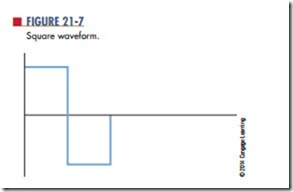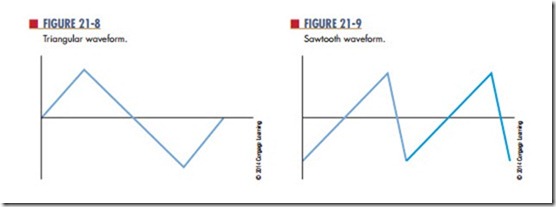nonsinusoidal Waveforms
The sine wave is the most common AC waveform. However, it is not the only type of waveform used in electronics. Waveforms other than sinusoidal (sine wave) are classified as nonsinusoidal waveforms. Specially designed electronic circuits generate nonsinusoidal waveforms.
Figures 21-7 through 21-9 show three of the basic nonsinusoidal waveforms. These waveforms can rep- resent either current or voltage. Figure 21-7 shows a square wave, so designated because its positive and negative alternations are square in shape. This indicates that the current or voltage immediately reaches its maximum value and remains there for the duration of the alternation. When the polarity changes, the current or voltage immediately reaches the opposite
peak value and remains there for the next duration. The pulse width is equal to one-half the period. The pulse width is the duration the voltage is at its maximum or peak value until it drops to its minimum value. The amplitude can be any value. The square wave is useful as an electronic signal because its characteristics can be changed easily.
Figure 21-8 shows a triangular waveform. It consists of positive and negative ramps of equal slope. During the positive alternation, the waveform rises at a linear rate from 0 to its peak value and then decreases back to 0. During the negative alternation, the wave- form declines in the negative direction at a linear rate to peak value and then returns to 0. The period of this waveform is measured from peak to peak. Triangular waveforms are used primarily as electronic signals.
Figure 21-9 shows a sawtooth waveform, which is a special case of the triangular wave. First it rises at a linear rate and then rapidly declines to its negative peak value. The positive ramp is of relatively long duration and has a smaller slope than the short ramp. Sawtooth waves are used to trigger the operations of electronic circuits. In television sets and oscilloscopes, they are used to sweep the electron beam across the screen, creating the image.
Pulse waveforms and other Nonsinusoidal wave- forms can be considered in two ways. One method considers the waveform as a momentary change in voltage followed, after a certain time interval, by an- other momentary change in voltage. The second method considers the waveform as the algebraic sum of many sine waves having different frequencies and amplitudes. This method is useful in the design of am- plifiers. If the amplifier cannot pass all the sine-wave frequencies, distortion results.
Nonsinusoidal waves are composed of the fundamental frequency and harmonics. The fundamental frequency represents the repetition rate of the wave- form. Harmonics are higher-frequency sine waves that are exact multiples of the fundamental frequency. odd harmonics are frequencies that are odd multiples of the fundamental frequency. even harmonics are frequencies that are even multiples of the fundamental frequency.
Square waves are composed of the fundamental fre- quency and all odd harmonics. Triangular waveforms are also composed of the fundamental frequency and all odd harmonics, but unlike the square wave, the odd harmonics are 180º out of phase with the fundamental frequency.
Sawtooth waveforms are composed of both even and odd harmonics. The even harmonics are 180º out of phase with the odd harmonics.
Questions
1. What are nonsinusoidal waveforms?
2. Draw two cycles of a
a. square wave
b. triangular wave
c. sawtooth wave
3. What are the two methods that nonsinusoidal waveforms are recognized in waveform development?
4. What are the applications of these nonsinusoidal waveforms?
5. Describe the fundamental frequency and harmonics of three different nonsinusoidal waveforms.

